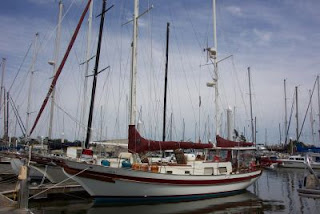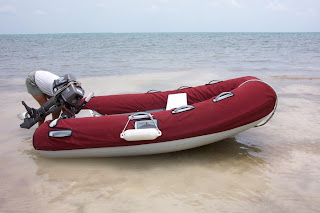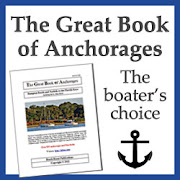
For about 10 years now we have been traveling up and down the ICW. We do not do the trip every year, but have 5 round trips under our belts. If you leave early enough from the
Chesapeake in September or October, you will have enough time to make side trips in North and
South Carolina and
Georgia to see new sights before the cold sets in. If you are pushing South because you left too late in the season and are being chased by frost, slow down when you hit the
Florida border.
One particular year we left later than we planned, not getting away from Baltimore until the third week in October. Granted, we had better weather than expected for the most part with very little frigid cold stuff, but still wanted to press on before the every-three-day-front pattern started. We always feel like once we get to Fernandina Beach, we can slow down a bit. This seems to be a sentiment now shared by many and, as we discovered this trip, a new trend has begun. Folks will bounce from St. Mary’s, Georgia to Cumberland Island, Georgia to Fernandina Beach, Florida and back to one or the other places for weeks on end. None of them are more than 8 or so miles apart and can be reached within the span of an hour or two, depending on how you hit the tides.
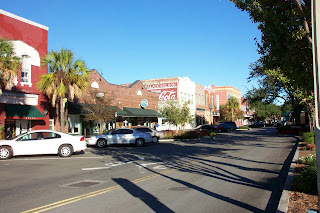
We have always stopped in
Fernandina Beach because we have friends who live there. We discovered many years ago that we do not, however, like to be in the anchorage in a good blow. An open fetch from the north or south and strong currents can make for anxious hours or days at anchor. One experience with others dragging down on us was enough. We now head upriver to St. Mary’s, which is much more protected, should weather be an issue. When the weather has passed, we simply up anchor in St. Mary’s and arrive back in Fernandina in under 2 hours (closer to 1 if the tide is right).
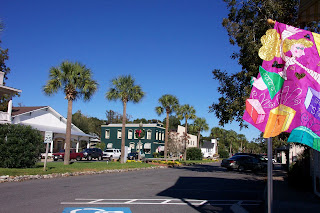
Since on this trip we arrived from an easy overnight offshore run from
Beaufort, S.C. and were anxious to see our friends, we went straight to the Fernandina anchorage and had a nap before getting together with our friends for the evening. After looking at the weather forecast for the next few days and realizing 25-30 knot winds were forecast, we decided it would behoove us to run upriver for a few days until the winds died down and we could resume our visit. We left the next day for St. Mary’s. We didn’t time our trip upriver very well with regard to the tides, but it really didn’t make too much difference as it is about 8 miles. We arrived in St. Mary’s and anchored just past Lang’s West, the second marina, on the North side of the river in about 8 feet at low tide, in a good holding mud bottom. Don’t forget the tides in this area run about 7 feet.
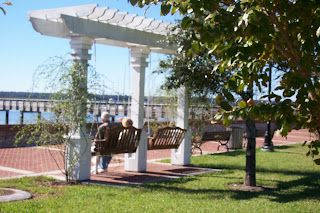
St. Mary’s,
Georgia, claiming to be the second oldest city in the country, is a quaint little town at the very edge of your waterway chart. Although Native Americans and Spaniards passed through this area as early as the mid 1500’s, St. Mary’s was not established as a town until done so by the British in 1787. St. Mary’s has a population of about 8,000 people and lives up to its reputation as a quiet village on the Georgia/Florida border. It is notable for its shops, restaurants, submarine museum and historic homes which line the waterfront. The
Howard Gilman Memorial Park opened in June of 2001. This attractive waterfront park lies just above Lang’s
Marina West. There is a fountain, swinging benches, brick walkways and a gazebo in the center inviting you to stroll or just sit and hold hands with your honey on a swing under a vine covered trellis. St. Mary’s is only a 30 minute ride from Jacksonville International if you have folks flying in and only 9 miles off of I-95 if you have guests coming by car. (See
www.stmaryswelcome.com for a walking map with points of interest.)
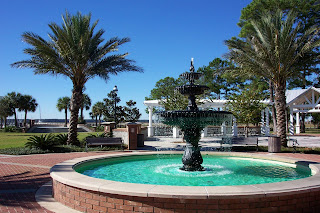
The group of roving sailboats planned to have their 3
rd annual Thanksgiving dinner in St. Mary’s. While anchored here, we were asked on at least 2 occasions if we needed to provision, do laundry or fill propane tanks. Folks who had procured rental cars or had friends in the area wanted to make sure everyone had what they needed. This was a refreshing experience having become a bit jaded by some earlier uncruiser-like behavior on the way down. We were also asked to stay for Thanksgiving, but had plans further down the road so bid our farewells.
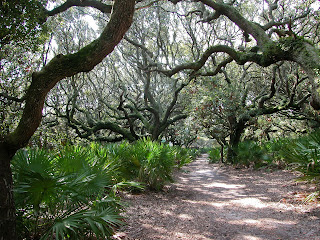
After a few days in St. Mary’s, folks would up anchor and run downriver for the 5-6 mile jaunt to
Cumberland Island. This pristine, stunning island is only accessible by air and water. There are no roads or bridges leading to
Cumberland. One anchors, then dinghies to shore at the designated docks. Don’t forget your $4 park entry fee when you go to shore. One can hike the miles of trails on the island or walk the long, sandy beaches and hunt for shells. Camping on the island is also permitted at designated sites for stays of no longer than 7 days and you must reserve in advance. You must also bring everything you need with you If you don’t feel like taking your boat to
Cumberland and
want to leave it in St. Mary’s, you can simply take the 45 minute ferry ride to the island for $12 per person for adults, $9 for senior citizens and $7 for children 12 and under. There is also the $4 park entry fee for ferry riders as well.
 Cumberland Island
Cumberland Island is a diverse ecosystem. The inland side is saltwater marsh teeming with life. Continue further toward the ocean and you will enter a live oak forest draped with Spanish moss. In their shadows, ferns abound as well as raccoons, armadillos and other animals rustling in the underbrush. The National Park Service provides a map which indicates the paths to the beaches and other points of interest. Please note the areas that are off limits to the public. The contrast from the dense green forest to the white, bright sand beach will take your breath away. The beach runs for an impressive 17 miles and wild horses can be found on the inland side beaches.
There are also a few structures on the island. The ruins of Dungeness, built in the late 1700’s, are not open to the public due to being unsafe structurally as well as being inhabited by diamondback rattlesnakes! There are 2 manor houses on the island, Greyfield and Plum Orchard Mansion. Greyfield is private property, but Plum Orchard was donated to the park service by the Carnegie family. The First African Baptist Church still stands near the North end of Cumberland Island, having been built in the late 1800’s and rebuilt in the 1930’s. Take your camera to shore as there are photo ops at every turn. Our trip South this year did not allow time for a stop in Cumberland, but gazed wistfully at the island as we drifted by on our way back to Fernandina.
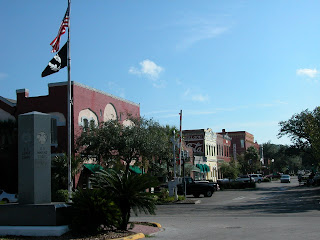
Much of the
Fernandina Beach waterfront is docks used for commercial ships, shrimpers and pleasure boaters. The Fernandina Harbor Marina is right on the ICW and has fuel and dockage alongside an extensive pier. Fernandina has the bustling
Centre Street running perpendicular to the waterfront. It has much more activity and shops than does St. Mary’s and is a good place to begin your Christmas shopping on your way South. Although any major provisioning is quite a distance from the marina, most folks seem to be able to catch a ride with some nice locals who take pity on them as they were once cruisers themselves. Downtown Fernandina encompasses a 50 block area with many homes and B&B’s listed in the National Registry of Historic Landmarks. Much of the architecture is Victorian. It boasts a whopping 25 restaurants within walking distance of the marina. For more information on this friendly town and the surrounding area go to
www.aboutamelia.com.
Having spent time in each of these three places, we fully understand the current trend toward staying in “the triangle” for weeks and enjoying the slower pace the South offers. So if you are heading South for the first time in the Fall or making a repeat passage, talk to other boaters on the VHF and find out what you can bring to Thanksgiving dinner in St. Mary’s or who is going to Cumberland to stroll the beach and join in the fun!
 For about 10 years now we have been traveling up and down the ICW. We do not do the trip every year, but have 5 round trips under our belts. If you leave early enough from the
For about 10 years now we have been traveling up and down the ICW. We do not do the trip every year, but have 5 round trips under our belts. If you leave early enough from the  We have always stopped in
We have always stopped in  Since on this trip we arrived from an easy overnight offshore run from
Since on this trip we arrived from an easy overnight offshore run from  St. Mary’s,
St. Mary’s,  The group of roving sailboats planned to have their 3rd annual Thanksgiving dinner in St. Mary’s. While anchored here, we were asked on at least 2 occasions if we needed to provision, do laundry or fill propane tanks. Folks who had procured rental cars or had friends in the area wanted to make sure everyone had what they needed. This was a refreshing experience having become a bit jaded by some earlier uncruiser-like behavior on the way down. We were also asked to stay for Thanksgiving, but had plans further down the road so bid our farewells.
The group of roving sailboats planned to have their 3rd annual Thanksgiving dinner in St. Mary’s. While anchored here, we were asked on at least 2 occasions if we needed to provision, do laundry or fill propane tanks. Folks who had procured rental cars or had friends in the area wanted to make sure everyone had what they needed. This was a refreshing experience having become a bit jaded by some earlier uncruiser-like behavior on the way down. We were also asked to stay for Thanksgiving, but had plans further down the road so bid our farewells.  After a few days in St. Mary’s, folks would up anchor and run downriver for the 5-6 mile jaunt to
After a few days in St. Mary’s, folks would up anchor and run downriver for the 5-6 mile jaunt to 

